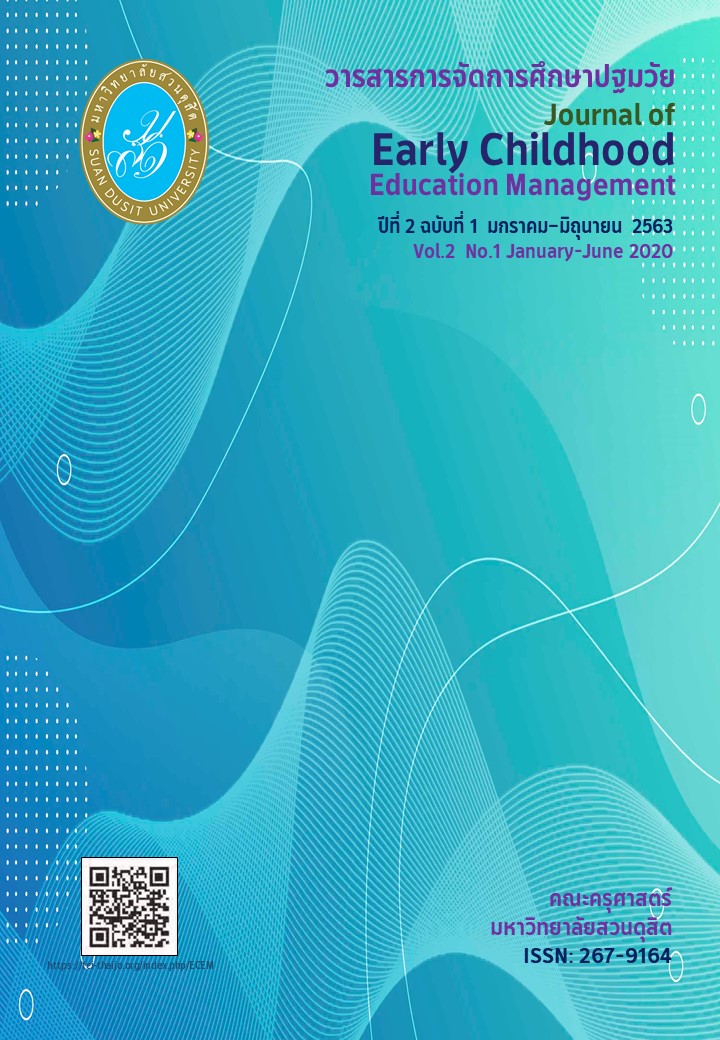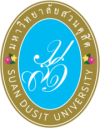Supporting Children with Disabilities to Develop Language and Communication Skills into Inclusion
คำสำคัญ:
Children with disabilities, General classrooms, Inclusion, Language and communication skills, Receptive and expressive languageบทคัดย่อ
Every child has the right to use their own voices with respect and dignity. Even though, some young children have difficulties with language and communication development; they still deserve their rights to express their needs, to ask for help, to make requests, and to receive attention. Listening to young children is a crucial contribution that grants support of their perceptions and can be designed into matters of meaningful support. Language and communication skills cover two principal purposes: (a) receptive language, and (b) expressive language. Receptive language describes the capacity of understanding others’ communication and showing interactive responses in appropriate ways. Expressive language describes the capacity for expressing needs by encompassing words, gestures, or facial expressions (verbal or nonverbal communication skills). Young children who are receiving proper supports in early language and communication development are more likely to be successful in academic and social learning. Two areas are included when developing language and communication skills: (1) Providing effective communication techniques, and (2) Creating the process of facilitated communication. This paper highlights these two areas and how they provide direct instructions and techniques for developing young children with disabilities in language and communication skills thus promoting positive responses with others in the general classrooms.
เอกสารอ้างอิง
Ata-Aktürk, A., & Demircan, H. Ö. (2017). Preschool teachers’ teacher-child communication skills: The role of self-efficacy beliefs and some demographics. Journal of Education and Human Development, 6(3), 86-97.
Autism Focused Intervention Resources and Modules. (2016). Picture exchange communication system (PECS): Step-by-step guide. Retrieved from https://afirm.fpg.unc.edu/sites/ afirm.fpg.unc.edu/files/imce/resources/PECS%20Step-by-Step.pdf
Bondy, A. S., & Frost, L. A. (1994). The picture exchange communication system. Focus on Autistic Behavior, 9, 1–19.
Cekaite, A. (November 2012). Child pragmatic development. Wiley Online Library.
Children Health Explanation. (October 2019). Communication & language development milestones 2-24 months chart.
Milestones of language development. Retrieved from http://www.childhealthexplanation. com/language-development-pg2.html
Communication Matters. (2015). Focus on what is AAC? Introduction to augmentative and alternative communication. ISAAC/UK. Retrieved from https://communicationmatters. org.uk/wp-content/uploads/2019/02/What-is-AAC.pdf
Cook, R. E., Klein, D., Tessier, A., & Daley, S. E. (2004). Adapting early childhood curricula for children in inclusive settings (6th ed.). Upper Saddle River, NJ: Merrill/ Prentice Hall.
Cortese, R. (October 2019). Helping toddlers expand language skills: Tips for encouraging kids age 0-5 to talk. Child Mind Institute. Retrieved from https://childmind.org/ article/helping-toddlers-expand-their-language-skills/
Dickins, M., & Williams, L. (2017). Listening as a way of life: Listening to young disabled children. National Children’s Bureau. Produced in association with the Council for Disabled Children. Retrieved from www.ncb.org.uk/sites/default/files/field/ attachment/Listening%20to%20Young%20Disabled%20Children.pdf
Flippin, M., Reszka, S., & Watson, L. R. (2010). Effectiveness of the picture exchange communication system (PECS) on communication and speech for children with autism spectrum disorders: A meta-analysis. American Journal of Speech-Language Pathology, 19, 178–195.
Hansen, S. G., Frantz, R. J., Machalicek, W., & Raulston, T. J. (2017). Advance social communication skills for young children with autism: A systematic review of single-case intervention studies. Review Journal of Autism and Developmental Disorders, 4, 225-242.
Hundert, J. P. (2007). Training classroom and resource preschool teachers to develop Inclusive class interventions for children with disabilities: Generalization to new intervention targets. Journal of Positive Behavior Interventions, 9(3), 159-173.
Kaiser, A. P., & Hester, P. P. (1994). Generalized effects of enhanced milieu teaching. Journal of Speech & Hearing Research, 37(6), 1320-40.
Kim, U. J., & Choi, H. S. (2003). The effects of Milieu Teaching procedures on the spoken language of children with autism. California State University, Kongju National University. Retrieved from https://www.e-csd.org/upload/8(3)_3.pdf
National Professional Development Center on Autism Spectrum Disorders. (2010). Picture exchange communication system (PECS): Steps for implementation. Retrieved from https://autismpdc.fpg.unc.edu/sites/autismpdc.fpg.unc.edu/files/PECS_Steps.pdf
Peckham-Hardin, K. D., Hanreddy, A., & Ogletree, B. T. (2018). Preparing teachers tofacilitate communication skills in students with severe disabilities. The U.S. Department of Education, Office of Special Education Programs. Retrieved from http://ceedar.education.ufl.edu/wp-content/uploads/2018/09/Preparing-Teachers-to-Facilitate-Communication-Skills-in-Students-With-Severe-Disabilities.pdf
Richard, G. J. (2000). The source for treatment methodologies in autism. IL: LiguiSystems.
Soodak, L. C. (2003). Classroom management in inclusive settings. Theory Into Practice, 42(4), 327-333.
The national association for the education of young children. (2009). Developmentally appropriate practice in early childhood programs serving children from birth through age 8. Retrieved from https://www.naeyc.org/sites/default/files/globally-shared/downloads/PDFs/resources/position-statements/PSDAP.pdf
ดาวน์โหลด
เผยแพร่แล้ว
รูปแบบการอ้างอิง
ฉบับ
ประเภทบทความ
สัญญาอนุญาต
ลิขสิทธิ์ต้นฉบับที่ได้รับการตีพิมพ์ในวารสารการจัดการทางการศึกษาปฐมวัย ถือเป็นกรรมสิทธิ์ของคณะครุศาสตร์ มหาวิทยาลัยสวนดุสิต ห้ามผู้ใดนำข้อความทั้งหมดหรือบางส่วนไปพิมพ์ซ้ำ เว้นแต่จะได้รับอนุญาตอย่างเป็นลายลักษณ์อักษรจากคณะครุศาสตร์ มหาวิทยาลัยสวนดุสิต นอกจากนี้ เนื้อหาที่ปรากฎในบทความเป็นความรับผิดชอบของผู้เขียน ทั้งนี้ไม่รวมความผิดพลาดอันเกิดจากเทคนิคการพิมพ์




